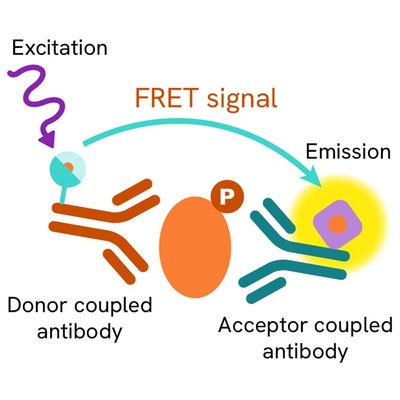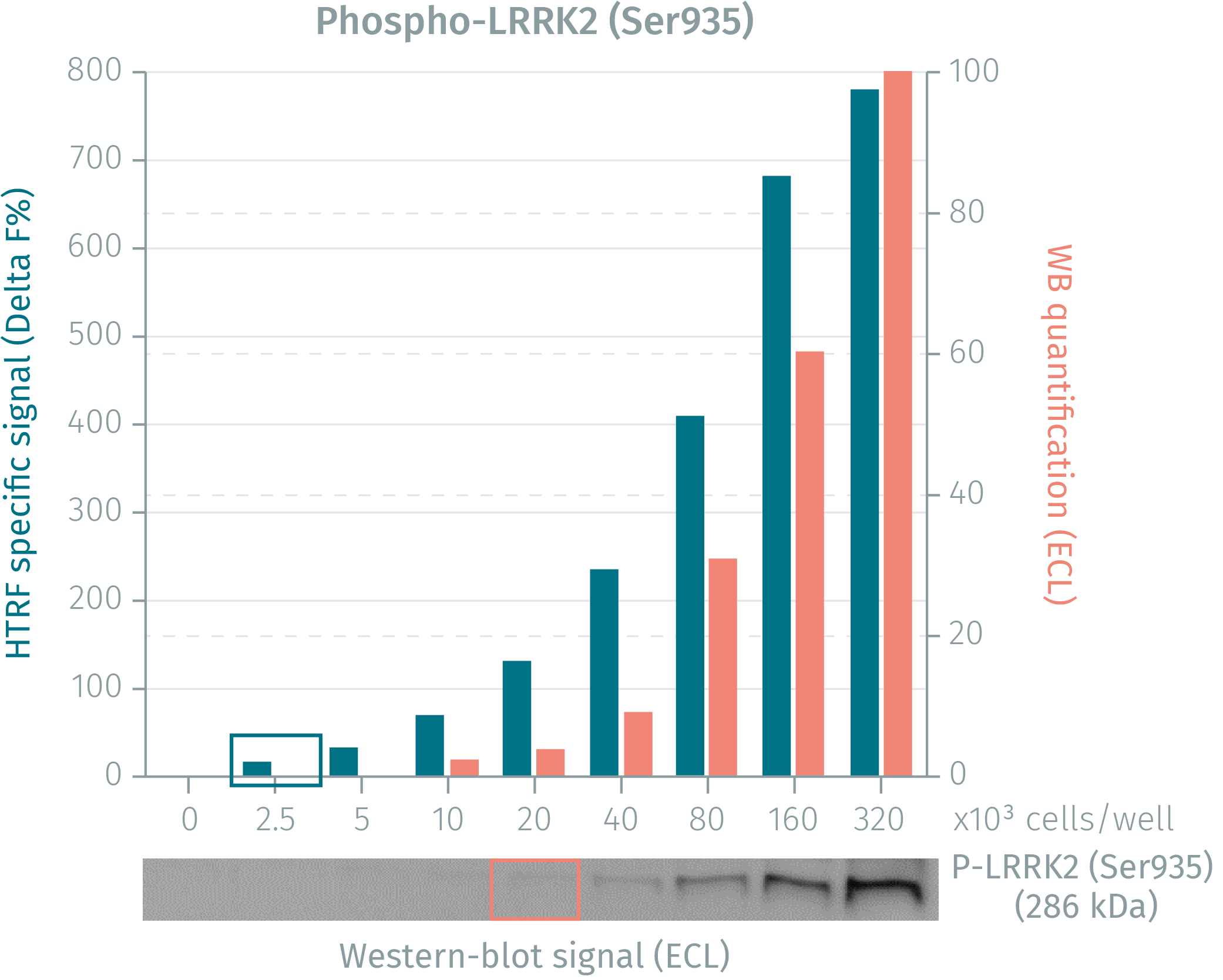

HTRF Human and Mouse Phospho-LRRK2 (Ser935) Detection Kit, 500 Assay Points








| Feature | Specification |
|---|---|
| Application | Cell Signaling |
| Sample Volume | 16 µL |









Product information
Overview
The phospho-LRRK2 (Ser935) kit measures endogenous LRRK2 protein phosphorylated at Ser935 directly in your cell type of interest. LRRK2 is a significant target in neuroscience research involving Parkinsons disease (PD) and neurodegenerative disorders in general.
How it works
Phospho-LRRK2 (Ser935) assay principle
The phospho-LRRK2 (Ser935) assay measures LRRK2 when phosphorylated at Ser935. Contrary to Western Blot, the assay is entirely plate-based and does not require gels, electrophoresis or transfer. The phospho-LRRK2 (Ser935) assay uses 2 labeled antibodies: one with a donor fluorophore, the other one with an acceptor. The first antibody is selected for its specific binding to the phosphorylated motif on the protein, the second for its ability to recognize the protein independent of its phosphorylation state. Protein phosphorylation enables an immune-complex formation involving both labeled antibodies and which brings the donor fluorophore into close proximity to the acceptor, thereby generating a FRET signal. Its intensity is directly proportional to the concentration of phosphorylated protein present in the sample, and provides a means of assessing the proteins phosphorylation state under a no-wash assay format.

Phospho-LRRK2 (Ser935) 2-plate assay protocol
The 2 plate protocol involves culturing cells in a 96-well plate before lysis then transferring lysates to a 384-well low volume detection plate before adding phospho-LRRK2 (Ser935) HTRF detection reagents. This protocol enables the cells' viability and confluence to be monitored.

Phospho-LRRK2 (Ser935) 1-plate assay protocol
Detection of phosphorylated LRRK2 (Ser935) with HTRF reagents can be performed in a single plate used for culturing, stimulation and lysis. No washing steps are required. This HTS designed protocol enables miniaturization while maintaining robust HTRF quality.

Assay validation
HTRF phospho-LRRK2 assay compared to Western Blot
Murine NIH-3T3 cells were cultured for 2 days until reaching 100% confluency. Following cell lysis, soluble fractions were then collected after a 10 min centrifugation. Serial dilutions of the cell lysate were performed in the supplemented lysis buffer and 16 µL of each dilution were dispensed and analyzed side-by-side by WB and by HTRF. The HTRF phospho-assay is 8-fold more sensitive than the Western Blot: only 2,500 cells are sufficient for minimal signal detection when using the HTRF phospho- LRRK2 assay while 20,000 cells are needed for a Western Blot signal.

Phospho LRRK2 detection in NIH 3T3 cells
Cells were cultured in 6-well plates and treated with increasing concentrations of CZC and GSK for 2 hours. Medium was removed and replaced with Revvity lysis buffer for 1 hour. 16 µL of lysate were taken from each well and transferred to a 384-well plate for detection with HTRF reagents. The Revvity phosphorylated LRRK2 assay enabled clear determination of both inhibitors IC50s, in agreement with literature.

Validation of Phospho-LRRK2 assay specificity for Ser935 phosphorylation using peptides
HEK293 cells were transfected in a T175 flask with a plasmid encoding the human mutant LRRK2 G2019S protein for 24 hours, and then treated with 100 nM Calyculin-A for 30 minutes. The cells were lysed with 3 mL of supplemented lysis buffer #4 for 30 minutes at RT under gentle shaking.
The competition assay was carried out in a 384-well low volume white microplate by dispensing 14 µL of cell lysate (previously diluted 100-fold in supplemented lysis buffer), 2 µL of each peptide (serially diluted in supplemented lysis buffer), and 4 µL of the HTRF Phospho-LRRK2 (Ser935) detection reagents. The HTRF signal was recorded on an EnVision Nexus reader after an incubation step of 4 hours at RT.
A dose-dependent inhibition of the HTRF signal was obtained with the LRRK2 phospho-Ser935 peptide, while the signal was unchanged in presence of the other peptides. These results demonstrate that the HTRF assay specifically detects the phosphorylated Ser935 residue on LRRK2.

Specifications
| Application |
Cell Signaling
|
|---|---|
| Brand |
HTRF
|
| Detection Modality |
HTRF
|
| Lysis Buffer Compatibility |
Lysis Buffer 4
Lysis Buffer 5
|
| Molecular Modification |
Phosphorylation
|
| Product Group |
Kit
|
| Sample Volume |
16 µL
|
| Shipping Conditions |
Shipped in Dry Ice
|
| Target Class |
Phosphoproteins
|
| Target Species |
Human
Mouse
|
| Technology |
TR-FRET
|
| Therapeutic Area |
Neuroscience
|
| Unit Size |
500 assay points
|
Video gallery
Resources
Are you looking for resources, click on the resource type to explore further.
Unlock the potential of HTRF™ LRRK2 immunoassays to support and advance Parkinson's disease drug discovery. This comprehensive...
This guide provides you an overview of HTRF applications in several therapeutic areas.


Loading...
How can we help you?
We are here to answer your questions.






























